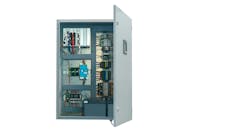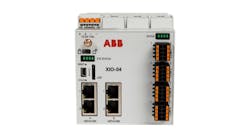Franz Ferre is product manager—controllers at Omron Automation.
What are the advantages of IO-Link in terms of diagnostics?
Franz Ferre, product manager—controllers, Omron Automation: IO-link has three main advantages for diagnostics.
First, regarding the IO-Link device itself, is it functioning properly, is the device starting to show wear, and will it need replacement soon? When IO-Link is installed, it is possible for the system to check itself compared to its expected performance and if there is a difference, a fault can be triggered.
Second, regarding wiring, an IO-Link system can detect wiring faults and pinpoint where they are in the system. In a traditional system it could take minutes to hours to pinpoint which circuit is having a fault or if there is fault present or not.
Third, IO-Link can help reduce troubleshooting during device replacement. This is because IO-Link can save all the optimal settings for each device in a system. So, if a device does fail, the operator can simply just replace the device and not have to worry about adjusting any of the settings to get the machine running again. This does require the programmer to save the settings in the IO-Link master so that they can be automatically restored. This feature is called automatic device replacement, or backup and restore, depending on manufacturer.
How does IO-Link handle multi-sensor devices? Can I configure and access data from individual sensors within a single IO-Link device?
Franz Ferre, product manager—controllers, Omron Automation: IO-link utilizes what is called an IO-Link master. An IO-Link master is basically a hub that multiple IO-Link sensors and devices can be plugged into. Then the IO-Link master consolidates all the data and communication of the IO-Link devices that are connected to it. The IO-Link master then communications all this consolidated data back to the controller/programmable logic controller (PLC)/industrial PC (IPC) via a single network cable.
What cable topology options are available with IO-Link? Can I use daisy-chain connections, or is a dedicated point-to-point connection required for each device?
Franz Ferre, product manager—controllers, Omron Automation: IO-Link is point to point. So, for each IO-Link device, a dedicated cable is required to connect the IO-Link device to the IO-Link master. IO-Link utilizes either four-pin or five-pin cables, typically M12. Four-pin M12, also known as Type A, is the most common. Type B, which utilizes five pins, has an extra pin available to provide further power for larger devices such as motors.
How does IO-Link integrate with different fieldbus protocols commonly used in automation systems?
Franz Ferre, product manager—controllers, Omron Automation: The IO-Link master acts as a gateway, or a converter, between IO-Link and the other commonly used protocols. The IO-Link master will typically have one or two network ports that support either one or multiple standard fieldbus protocols. The most common protocols are EtherNetIP, EtherCAT and ProfiNet. Nowadays, there are IO-Link masters for most of the known field networks.
What are the cost implications of implementing IO-Link compared to traditional wiring methods? Is the upfront cost of IO-Link devices offset by long-term benefits like reduced wiring complexity and improved diagnostics?
Franz Ferre, product manager—controllers, Omron Automation: It really depends on the system, what kind of IO-Link devices are desired and how far the devices will be mounted away from the main control cabinet. When considering the cost of IO-Link, it is best to consider all the costs involved. For a standard system, this will include the cabling, the costs to have a panel built by a certified panel builder, the costs of analog devices and analog IO cards. For an IO-Link system, cabling costs are usually reduced, as well as panel-building costs, and IO-Link can replace analog devices in many systems furthering the total cost. Oftentimes, the total cost is roughly the same between a standard system and an IO-Link system.
The largest upfront cost will be in engineering. Engineering will need to learn how to implement IO-Link in a way that maximizes all the benefits. This can take some time for them to create templates and program function blocks. Once the engineering has spent the upfront time, they will find that there are many tools with IO-Link that can reduce their programming efforts.
Anything else that you'd like to add about IO-Link?
Franz Ferre, product manager—controllers, Omron Automation: In the past, IO-link specifications have often been driven by the end user. Recently more original equipment manufacturers (OEMs) and system integrators are starting to implement IO-Link more. This is because they can be more confident in offering machines and services with reduced maintenance requirements for their end customers. Also, with a properly implemented IO-Link system, the amount of customer technical support will also be reduced.
The amount of installed IO-Link devices has been growing on an exponential curve, and the number of manufacturers offering IO-Link devices and solutions has also greatly increased.
Tell us about one of your organization’s state-of-the-art IO-Link offerings.
Franz Ferre, product manager—controllers, Omron Automation: Omron’s new NXR Series IO-Link master is the first in the industry to offer "PC-less maintenance," enabling customers to set up and replace the IO-Link master without special software or a PC connection. This allows anyone on staff to be able to perform maintenance, without any special tools or PC software.
Additionally, upfront engineering costs for implementing IO-Link can be drastically reduced when combining the NXR EtherCAT with an Omron NX or NJ Sysmac PLC. This is because Omron’s PLC software can automatically configure IO-Link devices into the PLC software. This saves engineers a lot of time by reducing the need to referencing multiple sensor manuals, and it can reduce manual data entry errors.






